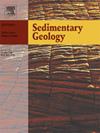Depositional environment and redox conditions of the Moncorvo Ironstone – Unveiling the evolution of ironstones under Rheic Ocean influence
IF 2.9
2区 地球科学
Q1 GEOLOGY
引用次数: 0
Abstract
Ironstones, as key archives of past marine environments, provide invaluable insights into Paleozoic history. Their mineralogy may reflect the physical-chemical conditions of the environment and the nature of available sediments. This study focuses on the Moncorvo Ironstone, a Lower-Middle Ordovician deposit formed during the opening of the Rheic Ocean. Here, we use an integrated approach combining sedimentology, petrology, and geochemistry to constrain the depositional settings and the redox landscape associated with the ironstone deposition. The Moncorvo Ironstone present some unusual characteristics, such as the lack of ooids, an uncommon mineralogy, and a stratigraphic thickness that can reach over >45 m, a remarkable feature for an ironstone. Our investigation reveals that this iron-rich sequence is distributed in two distinct marine environments: an inner shelf and a middle to distal shelf. Each environment has a unique mineral assemblage. Despite the influence of metamorphism and deformation, evidence suggests that much of the mineralogy and texture of this deposit still preserve characteristics of the original sediments. Finally, our findings, alongside a careful assessment of the mineralogy of other ironstones of similar age, suggest a strong stratification of the Rheic Ocean throughout the Early and Middle Ordovician.

Moncorvo铁矿沉积环境与氧化还原条件——揭示大洋影响下的铁矿演化
铁石,作为过去海洋环境的重要档案,提供了对古生代历史的宝贵见解。它们的矿物学可以反映环境的物理化学条件和可用沉积物的性质。Moncorvo铁矿是中奥陶统下第三纪沉积,形成于大洋打开时期。本文采用沉积学、岩石学和地球化学相结合的综合方法来约束与铁矿沉积相关的沉积背景和氧化还原景观。Moncorvo铁矿具有一些不寻常的特征,如缺乏流体,不寻常的矿物学,地层厚度可达45米以上,这是一种铁矿的显著特征。我们的研究表明,这一富铁层序分布在两个不同的海洋环境中:一个内陆架和一个中至远陆架。每种环境都有独特的矿物组合。尽管受到变质作用和变形作用的影响,但有证据表明,该矿床的大部分矿物学和结构仍保留了原始沉积物的特征。最后,我们的发现,加上对其他类似年龄的铁矿的矿物学的仔细评估,表明贯穿早奥陶纪和中奥陶纪的莱西海有很强的分层作用。
本文章由计算机程序翻译,如有差异,请以英文原文为准。
求助全文
约1分钟内获得全文
求助全文
来源期刊

Sedimentary Geology
地学-地质学
CiteScore
5.10
自引率
7.10%
发文量
133
审稿时长
32 days
期刊介绍:
Sedimentary Geology is a journal that rapidly publishes high quality, original research and review papers that cover all aspects of sediments and sedimentary rocks at all spatial and temporal scales. Submitted papers must make a significant contribution to the field of study and must place the research in a broad context, so that it is of interest to the diverse, international readership of the journal. Papers that are largely descriptive in nature, of limited scope or local geographical significance, or based on limited data will not be considered for publication.
 求助内容:
求助内容: 应助结果提醒方式:
应助结果提醒方式:


